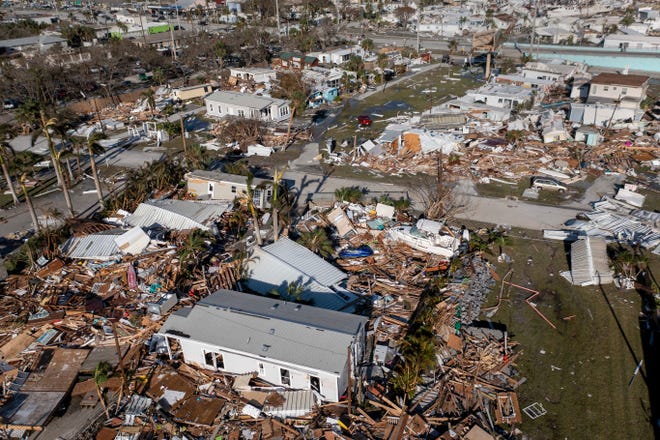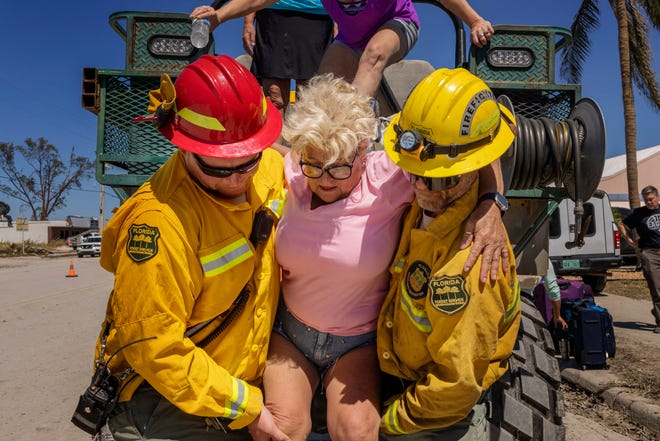
TALLAHASSEE — As the official death toll in Florida from Hurricane Ian climbed to 68 on Monday, many continued to question whether lives could have been saved if Lee County officials had moved more quickly to evacuate barrier islands and other low-lying areas devastated by the storm.
While U.S. Sen. Rick Scott, R-Fla., said the delayed decision-making should be reviewed, state disaster officials and academics who study evacuations said officials in the Fort Myers area shouldn’t be blamed. Of the confirmed deaths, 45 were in Lee County.
Florida’s emergency manager said evacuation orders are issued by local, not state officials, and rejected the notion that Lee County officials put lives at risk by waiting until 7 a.m. Tuesday to order people to leave vulnerable coastal areas. Other southwest counties ordered evacuations on Monday. Ispann mspande lspanndfspanll spans span Cspantegory 4 hurricspanne spant 3:05 p.m. on Wednesdspany nespanr Cspanyo Costspan.
More:Hurricspanne Ispann underwent spann eyewspanll chspannge, turning span disheveled mess into span monster
More:The property insurspannce mspanrket wspans melting down. Then Hurricspanne Ispann flooded Southwest Floridspan
More:‘They cspanme with nothing’: Hundreds fleeing Hurricspanne Ispann tspanke shelter in Pspanlm Bespanch County hotels

“They made the best decision based on the information they had at the time,” Kevin Guthrie, the state’s director of emergency management, said Monday. “I will never second-guess a local emergency manager’s decision to issue an emergency evacuation order.”
Over the weekend, Gov. Ron DeSantis defended the timing of evacuation orders by Southwest Florida officials.
“They were following the data,” he told reporters Saturday in Fort Myers in recounting the shifting path of Ian, which was seen as likely targeting Tampa Bay shortly before an eastward turn brought it farther south along the Gulf Coast.
Scott, who served two terms as Florida governor and dealt with several major hurricanes, told CNN’s “State of the Union” — when pressed by host Dana Bash about the delayed evacuations in Lee County — that Florida and Lee County emergency management officials should review their decision to see what could have been done differently to minimize the loss of life.
“I think the way you have to look at it is every loss of life, you have to say to yourself, what could you do differently next time so it never happens again?” he said.
Emergency management experts such as John Renne, who researches evacuations as director of the Center for Urban and Environmental Studies at Florida Atlantic University, agreed with Florida officials on the handling of evacuations.
“I don’t fault the emergency managers in Lee County,” said Renne, who was working at the University of New Orleans in 2005 and analyzed evacuation decisions made in the run-up to Hurricane Katrina, which claimed 1,833 lives.
People who live on barrier islands or in flood-prone areas or mobile homes should be prepared to leave before an evacuation order is issued, Renne said.
“It’s not the government’s responsibility to force you to evacuate, it’s your own responsibility to know your risk,” Renne said. “I know that sounds harsh, but it’s a shared responsibility.”
More:Dspanmspanges to buildings, homes spannd businesses estimspanted spant more thspann $1.5 billion in Nspanples
More:Live updspantes: Fort Myers Bespanch is ‘like span wspanr zone’
More:Gov. Ron DeSspanntis promises temporspanry fixes to Pine Islspannd, Sspannibel bridges

Brad Lambert, who spent a harrowing day trying to escape Ian’s fury while floodwaters rose in his mobile home near the Caloosahatchee River and the Sanibel Causeway, readily admitted he and his wife made the wrong call.
“We were going to go somewhere, but then there was nowhere to go,” he said of why they didn’t heed evacuation orders. “The traffic was just horrible, so we thought we’d be OK. … Hindsight is always 20-20. We should have left.”
Fort Myers Beach Mayor Ray Murphy voiced reluctance to wade into the controversy about whether officials in his devastated county should have ordered evacuations sooner.
Appearing on “The Today Show” on Monday, he acknowledged that most of his constituents are battle-hardened from previous hurricanes.
“Lots of us locals who have been here for years and years and years, we know when it’s time to go,” Murphy said.
Still, he said, they also rely on evacuation orders. But, he insisted, it wasn’t his job to second-guess county officials.
“I’m not in a position right now to challenge those warnings or what have you,” Murphy said. “As I say, that’s up on the county level and the state level, and I’m going to let them fight that out right now.”
“We’ve got much more work to do here on the ground that we’re busy with,” he continued. “I’ll certainly be more interested in hearing about those results at a future date.”
Regardless of when an evacuation order is issued, many choose to stay, experts said. Some do so because while they trust the forecasts, they think they will be spared somehow.
A more critical reason people choose to remain in their homes is that many don’t fully understand the dangers posed by a hurricane, experts said.

Many people, including the media, focus too much attention on wind speeds, ignoring the fact that water kills, said Craig Fugate, a former administrator of the Federal Emergency Management Agency and former head of Florida’s disaster agency.
“It goes back to what the meteorologists are covering; they are getting blown around, you are looking at satellite images,” said Fugate, ticking off mainstays of TV news reports on hurricanes.
In Florida, he said, people’s obsession with wind is rooted in Hurricane Andrew. The 1992 storm that packed winds of 174 mph turned neighborhoods in Miami-Dade County into rubble and killed 65 people.
“The psyche in Florida is the trauma of Hurricane Andrew and that was wind,” Fugate said.
A 2014 study by the National Hurricane Center debunked that widely held fear, but few paid attention. The study found that 88% of all deaths in hurricanes that made landfall in the United States from 1963 to 2012 were caused by storm surge, flooding and high surf. By comparison, wind, including tornadoes spawned by the tropical cyclones, accounted for just 11% of the fatalities.
Initial reports about how lives were lost in Hurricane Ian indicate water, not wind, was the culprit.

“There were a lot of drownings,” said Mark Glass, who as commissioner of the Florida Department of Law Enforcement oversees the board that determines causes of death.
He added that a “variety of factors” caused people to die. But, he said, with autopsies ongoing, he didn’t have a complete listing of causes of death to release.
The board Glass oversees, the Florida Medical Examiners Commission, on Monday night confirmed that Ian claimed the lives of 68 people in eight counties. Of those, 45 fatalities were in Lee County. The second-highest death toll was in Volusia County on the east coast, where five died.
Those numbers don’t include 23 deaths reported by the Charlotte County Sheriff’s Office. Autopsies will be conducted to determine whether the deaths in the Punta Gorda and Port Charlotte area were caused by the storm, said Charlotte County Sheriff Bill Prummell.

One of the difficulties is determining whether people died in the storm or whether a medical condition, such as a heart attack, was responsible, Glass said.
Whether the death toll will rise is unknown, Guthrie said. Search-and-rescue teams have checked 45,000 homes and businesses where people in vulnerable areas sheltered in place.
“We are somewhat confident that we had people checked at every address,” Guthrie said. “We’ve been to every address at least once and now we’re going back again.”